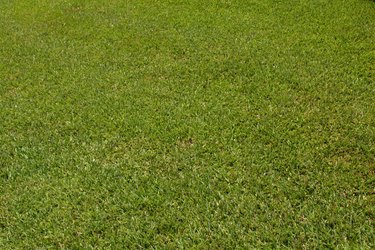
Thatch is a mixture of both dead and living organic matter that it sandwiched between the soil and the green matter of your lawn. The amount of thatch you have depends on cultural practices and environmental conditions that help the thatch build up. A thick layer of thatch makes a hospitable environment for a host of pests and fungal diseases. By fertilizing after thatch removal, you help the grass compete with weeds.
Determine If You Need to Remove Thatch
Video of the Day
Thatch on lawns is not necessarily bad for the yard. It can help insulate against cold weather and lock in moisture. New lawns generally do not accumulate any thatch until several years after they have been established. Some grasses like Bermuda grass will produce more thatch than ryegrass. A thick layer of thatch will prevent water and fertilizer from reaching the grass roots. Find out if you need to dethatch your yard by using a knife to cut a wedge of turf down to the soil. If there is less than 1/4 inch of thatch, you do not need to dethatch. Remove thatch that is 1/2- to 1-inch thick once a year, and thatch that is 1 to 1 1/2 inches twice a year.
Video of the Day
When to Remove Thatch and Fertilize
Keep an annual dethatching schedule in the spring to reduce the amount of thatch produced in your yard. Because you fertilize your yard immediately after dethatching, it is best to wait until your yard has "greened" up before applying nitrogen. If you fertilize while your grass is still dormant, you encourage weeds to compete with your grass. Rent a dethatcher at your local gardening supply store if you have a large yard. For small yards, a rake will be able to pick up thatch without too much effort on your part. Once you have dethatched, you should apply a fertilizer that has the right NPK (nitrogen, phosphorous and potassium). Too much nitrogen will exacerbate your thatch problem in the future.
Fertilizer
Decide if you want to use a liquid quick-release or granule slow-release fertilizer. Quick release will quickly supply your grass with nutrients and give you the fastest results, but it has to be applied every couple of weeks. Slow release will provide nutrients for a longer amount of time, but will take a few weeks before your lawn benefit from the results. Choose a fertilizer that is rich in nitrogen for getting your yard off on the right foot. As the summer months go by, switch to a phosphorus rich fertilizer because encouraging new growth in the fall months will leave your lawn vulnerable in the winter. Make sure that you water your lawn a couple of days prior to fertilizing. Nitrogen can "burn" up a lawn or cause it to become dehydrated. Always water thoroughly after fertilizing to help the nutrients reach grass roots and prevent a brown lawn.